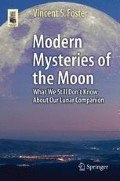Abstract
A number of theories on how the Moon formed are explored here, including captured body, fission, formed together (condensation theory), planetesimal collisions (formed from asteroid-like bodies), and collision theories. All of these have been challenged, and none satisfy all questions. But the favored theory that emerged from the Apollo missions is the Giant Impact Hypothesis (sometimes called the Big Splat). This states that our Moon was created by a collision between Earth and a Mars-sized object some 4.5 billion years ago. The chapter also explores the rarity of this type of collision arising, at most in only 5–10 % of planetary systems.
Access this chapter
Tax calculation will be finalised at checkout
Purchases are for personal use only
Author information
Authors and Affiliations
Rights and permissions
Copyright information
© 2016 Springer International Publishing Switzerland
About this chapter
Cite this chapter
Foster, V.S. (2016). How the Moon Formed. In: Modern Mysteries of the Moon. Astronomers' Universe. Springer, Cham. https://doi.org/10.1007/978-3-319-22120-5_3
Download citation
DOI: https://doi.org/10.1007/978-3-319-22120-5_3
Publisher Name: Springer, Cham
Print ISBN: 978-3-319-22119-9
Online ISBN: 978-3-319-22120-5
eBook Packages: Physics and AstronomyPhysics and Astronomy (R0)

